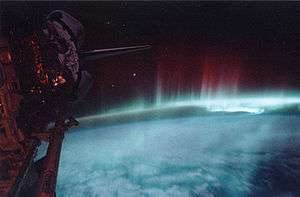Batteries in space
Chemical batteries are usually used in outer space as a means of power generation. Batteries generate voltage by creating an electric potential between chemicals with different properties. Rechargeable batteries can store electricity channeled from an outside source, causing a reverse reaction between these chemicals. The table below lists common battery types used in space.
| Battery type | Formula | Specific energy (W*hr)/kg |
Notes |
|---|---|---|---|
| Hydrogen Fuel Cell | H | 275 | [2] |
| Lithium–sulfur dioxide | LiSO2 | 200 | [2] |
| Lithium–thionyl chloride | LiSOCl2 | 200 | [2] |
| Lithium-bromine in thionyl chloride | Li-BCX | [3] | |
| Lithum-Iron disulfide | LiFeS2 | [4] | |
| Nickel–cadmium | NiCd | 30 | [2] |
| Nickel–hydrogen | NiH2 | 60 | [2] |
| Sodium-sulfur | Na-S | [3] | |
| Silver-cadmium | Ag-Cd | [3] | |
| Silver–zinc | AgZn | 100 | [2] |
| Zinc-mercury oxide | Zn-HgO | [3] | |
See also
- List of spacecraft powered by non-rechargeable batteries
- Solar panels on spacecraft
- Nuclear power in space
References
- ↑ Hubble Space Telescope Servicing Mission 4 Batteries
- 1 2 3 4 5 6 7 Ball, et al. - Planetary Landers and Entry Probes - Page 102
- 1 2 3 4 5 G. Halpert, et al.- Batteries and Fuel Cells in Space
- ↑ J. Jeevarajan - Comparison of Safety of Two Primary Lithium Batteries for the Orbiter Wing Leading Edge Impact Sensors
External links
This article is issued from Wikipedia - version of the 7/27/2016. The text is available under the Creative Commons Attribution/Share Alike but additional terms may apply for the media files.

